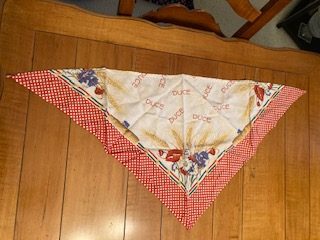A Family Museum

Madeline Northup
Right before my grandfather passed away in August of 2020, my immediate family and my grandparents had an Independence Day party. It was a wonderful day- we sat around outside, my grandfather soaking in the sun blissfully after being in the hospital for so long recovering from MRSA. My brother and I sat with him, silently enjoying his presence while staring out at the neighborhood festivities. As the fire truck leading the train of children on bikes passed us by, my grandfather squeezed both of our arms, and said, every so quietly, that he had something to give us. To my brother, he bestowed his prized trumpet; the same trumpet he had played on the Ed Sullivan show and in the Air Force Band. Growing up, my mother and sisters were never allowed to touch it. Now, though, my grandfather saw the spark of a great musician in my brother. He knew his prized possession would be in good hands.
Turning to me, my grandfather became more somber. Grasping my hand, he told me my gift was different from my brother’s: it couldn’t be used, touched, or worn. It was something to cherish as history, a memory of times never to be repeated. It was his scarf that he had worn as a little boy in Italy during World War II; a government issued scarf created by none other than Benito Mussolini.

I gaped at him, unable to express even shock in the moment. He had kept this scarf all these years, most of his lifetime, as a reminder of the dangers of human power, and a time that he worked to never see again. He trusted me to tell his story, something that I have been working on for years. I had never felt so intimidated and excited in all my life.
Fast forward three years, the scarf and that conversation had become a distant memory. It was not until I was helping my parents excavate all the treasures in my grandparents’ basement that I found it, covered in dust. Shaking it off, I realized what I had in my hand: a piece of dangerous, raw, and morbid history.
Running my fingers along the seam, I saw that it was, surprisingly, in pristine condition. Gorgeous red, white, and blue flowers emblazoned the sides of the scarf with pieces of wheat popping up amongst them. A checkered border gave it a picnic blanket style, dainty in comparison to what I found in the middle. In bright red letters, all capitalized, was the word “duce,” printed repeatedly on the material. Beside the multiple “duce” prints, known as Mussolini’s title, were two symbols of the fascist regime: a bundle of sticks tied together and attached to an axe. If there was ever a sign of vanity, this was it.


As I held it, I couldn’t help but imagine what my grandfather would have felt as a young boy wearing this scarf. The same young boy who had helped his parents hide American soldiers in their basement from the Nazis would have been appalled by this show of ostentatious evil. But, if he hadn’t complied, the consequences of his rebellion would have been far worse. He could remember a time when King Victor Emmanuel III would throw oranges out of his car to the people in his village, waving excitedly to his citizens. Mussolini was different: he commanded the room with rage and fear. While my grandfather was scared of him as a child, as he grew up, that fear turned to disgust. “What a coward he was,” my grandfather would say, “when he came to my school, he didn’t even have the nerve to talk to a child. He would only stare.”
So why did my grandfather keep this reminder of a time so difficult and desperate? Well, this wasn’t the only thing he kept. His house was filled with memories and mementos, all from a life lived long ago. He had created a museum for me and my family to foster for future generations. The scarf was a part of that history, early in the story of his life, that served as a reminder of the hardships he had endured. It is the humble and hopeless beginning to a life that turned for the better. I only hope to continue to add to this museum with my own life, for history can come from the most unlikely of people and places.